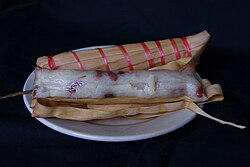Lepet
This articleneeds additional citations forverification.Please helpimprove this articlebyadding citations to reliable sources.Unsourced material may be challenged and removed. Find sources:"Lepet"–news·newspapers·books·scholar·JSTOR(July 2014)(Learn how and when to remove this message) |
 Lepet, sticky rice dumpling with peanuts cooked in coconut milk | |
| Alternative names | Leupeut (Sundanese), Lepat (Indonesian) |
|---|---|
| Type | Dumpling |
| Place of origin | Indonesia |
| Region or state | Java |
| Main ingredients | Sticky rice,coconut milk,peanuts,wrapped in young coconut leaf |
Lepet(Javanese),Leupeut(Sundanese), orLepat(Indonesian) is a type ofsticky ricedumplingmixed withpeanutscooked withcoconut milkand packed inside ajanur(young coconut leaf) orpalm leaf.It is a delicacy commonly found inJavaneseandSundanese cuisine(ofJava,Indonesia), and often consumed as a snack. It is similar tolontong,but with a stickier texture and richer flavor due to the use of coconut milk and peanuts.
Lepet is made bysteamingtheketan(sticky rice) until half cooked incoconut milkthen mixed withpandan leafandsaltuntil all of the coconut milk is absorbed into the sticky rice. Then the half-cooked coconut milk sticky rice is mixed further with gratedcoconutflesh and peanuts then wrapped insidejanur(young yellowish coconut leaf) in a cylindrical-shape and secured with strings made from coconut leaf fibers (or any kind of strings). The rice packages inside the coconut leaf are then steamed further until completely cooked. The most common filling ispeanuts,however other kinds of beans such askidney beans,cowpeas,jack beans,orcornmight also be used.[1]
Other than sticky rice, lepet can be made from corn as well, which is similar totamale.[2]
In theSundanesearea ofWest Java,it is known asleupeutand usually made in a smaller size with peanut filling and usually consumed withtahu sumedang(friedtofu). It is a popular snack in theKuninganandSumedang Regency.
In Sumatra, Indonesia and the Malay Peninsula there is a similarly named food known as lepat, although the recipe and method are slightly different as lepat usespalm sugarand grated coconut flesh fillings which are wrapped inside abanana leafinstead of a young coconut leaf.
See also
[edit]References
[edit]- ^"Lepet Ketan & Kacang Tolo"(in Indonesian). Sajian Sedap.Retrieved31 July2014.
- ^"Lepet Jagung"(in Indonesian).Retrieved13 December2022.
External links
[edit]| Wet (basah) |
| |
|---|---|---|
| Dry (kering) | ||
| Dishes |
| ||||||||||||||||||||||||||||||||||||||||||||||||
|---|---|---|---|---|---|---|---|---|---|---|---|---|---|---|---|---|---|---|---|---|---|---|---|---|---|---|---|---|---|---|---|---|---|---|---|---|---|---|---|---|---|---|---|---|---|---|---|---|---|
| Snacks |
| ||||||||||||||||||||||||||||||||||||||||||||||||
| Beverages |
| ||||||||||||||||||||||||||||||||||||||||||||||||
| Bumbu |
| ||||||||||||||||||||||||||||||||||||||||||||||||
| Influencesand overseas dishes |
| ||||||||||||||||||||||||||||||||||||||||||||||||
| List articles | |||||||||||||||||||||||||||||||||||||||||||||||||
| Related topics | |||||||||||||||||||||||||||||||||||||||||||||||||

